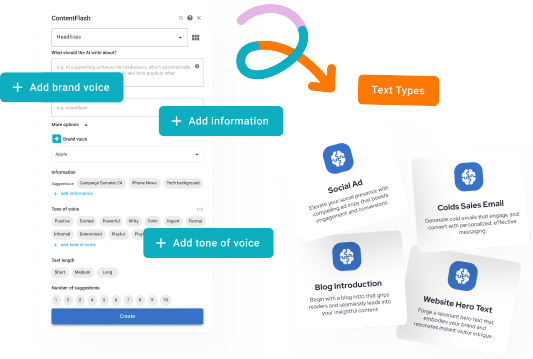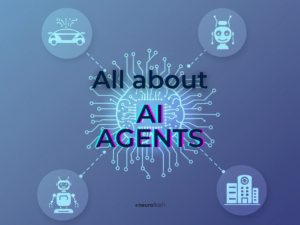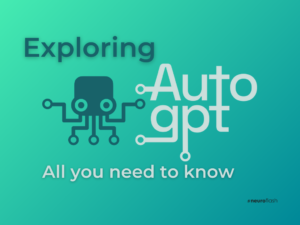Imagine a world where your devices not only respond to your commands but also anticipate your needs, learn from your behaviors, and act autonomously to assist you. This is the realm of AI agents—intelligent systems designed to perceive their environment, make decisions, and perform tasks with minimal human intervention. From virtual assistants like Siri and Alexa to autonomous vehicles and advanced customer service bots, AI agents are increasingly becoming an integral part of our daily lives, transforming the way we interact with technology.
How Do AI Agents Work?
At the core of many AI agents are large language models (LLMs), which process and generate human-like text based on vast datasets. However, AI agents extend beyond mere language processing. They can plan tasks, utilize external tools, and adapt their actions based on feedback. This involves three primary stages:
Goal Initialization and Planning: The agent receives a specific goal from the user and devises a plan by breaking it down into manageable tasks and subtasks.
Reasoning Using Available Tools: To accomplish its tasks, the agent may access external data sources, perform web searches, or interact with other agents to gather necessary information.
Learning and Reflection: After completing tasks, the agent evaluates its performance, learns from feedback, and adjusts future actions to improve accuracy and efficiency.
For instance, if you ask an AI agent to plan a trip, it can search for flights, compare prices, book accommodations, and even suggest activities at your destination, all while learning your preferences to tailor future recommendations.
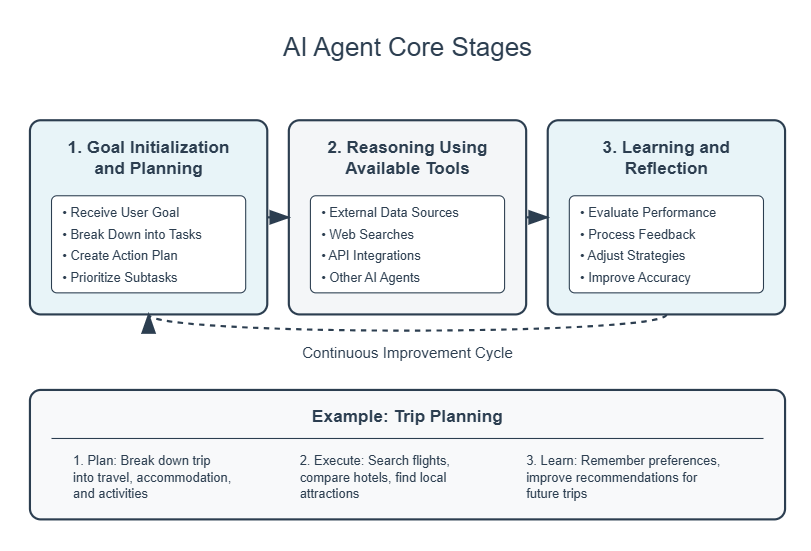
Let’s see how this works in action. Imagine you’re planning a surfing trip with the help of an AI agent. It checks wave conditions, weather forecasts, and travel options, adjusting your itinerary in real-time. If a better surf spot emerges, the agent updates your destination, reschedules your rental, and optimizes your travel plans—ensuring the best possible experience with minimal effort on your part.
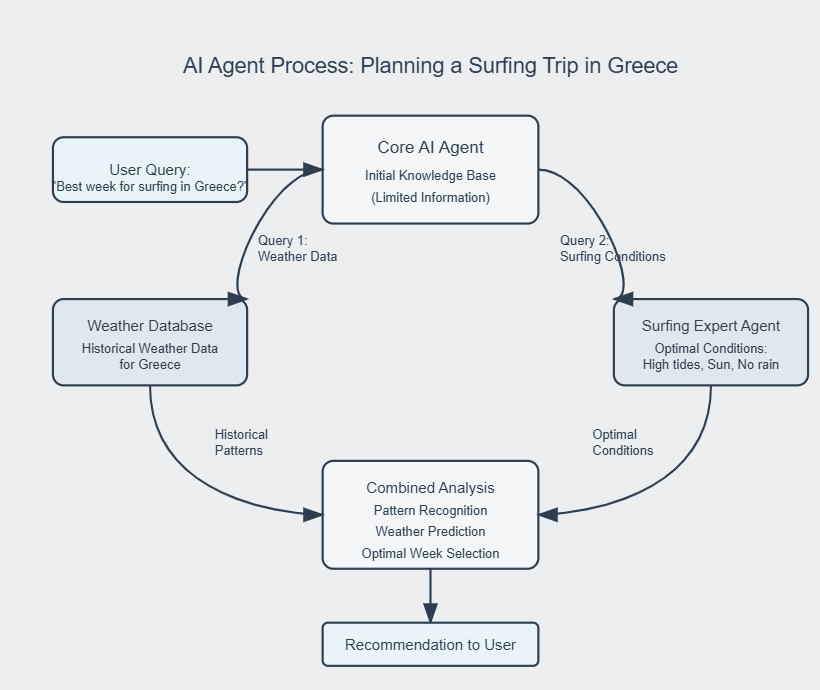
Key Components of AI Agent System
- Input Layer:
- Handles user queries and system events
- Serves as the initial point of interaction
- Core Agent:
- Memory System for maintaining context and learning
- Reasoning Engine for decision-making and planning
- Tool Integration Layer for connecting with external services
- External Tools:
- APIs and web services
- Databases
- Custom tools and integrations
- Output Generation:
- Responses and recommendations
- Action execution
- Feedback Loop:
- Enables continuous learning and improvement
- Connects output back to input for iterative enhancement
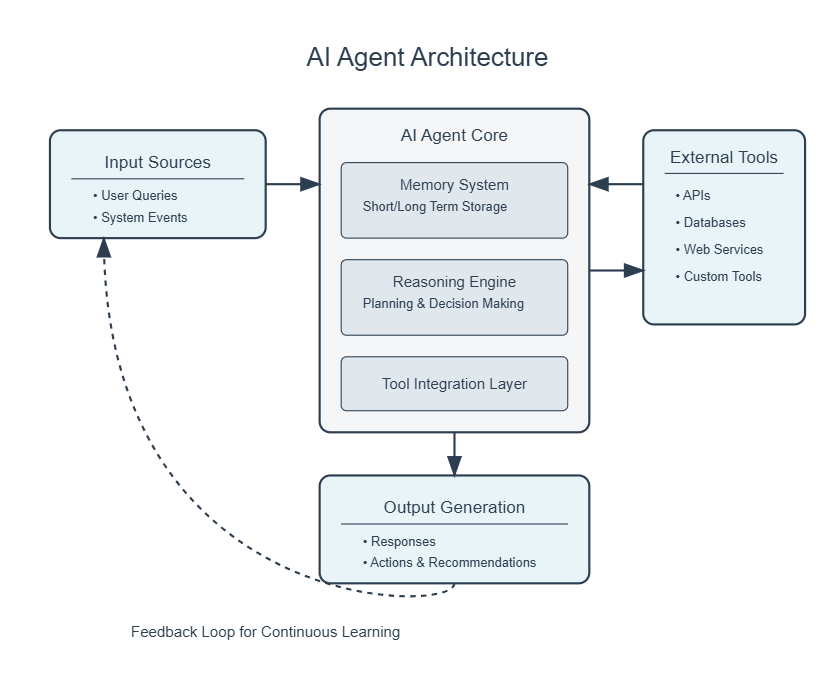
Types of AI Agents
AI agents can be categorized based on their complexity and capabilities:
Simple Reflex Agents: These agents respond directly to current perceptions without considering past experiences. For example, a thermostat that turns on heating when the temperature drops below a certain point operates on simple reflex rules.
Model-Based Reflex Agents: These agents maintain an internal model of the world, allowing them to handle partially observable environments. A self-driving car that keeps track of nearby vehicles and pedestrians to navigate safely exemplifies this type.
Goal-Based Agents: These agents act to achieve specific goals. For instance, a chess-playing AI evaluates different moves to checkmate the opponent.
Utility-Based Agents: These agents aim to maximize a utility function, balancing various factors to achieve the best outcome. An autonomous drone delivering packages might consider factors like distance, battery life, and weather conditions to optimize its deliveries.
Learning Agents: These agents improve their performance over time by learning from experiences. Virtual assistants like Siri or Alexa learn user preferences to provide more personalized assistance.
Multi-Agent Systems: These involve multiple agents interacting to achieve individual or shared goals. In a smart grid, various agents manage different parts of the power distribution system to optimize overall efficiency.
Hierarchical Agents: These agents are organized in a hierarchy, with higher-level agents overseeing the behavior of lower-level agents. In robotics, a high-level agent might plan a task, while lower-level agents control specific movements.
Each type of agent is designed to operate effectively within its specific context, contributing to the diverse applications of AI in our daily lives.
Learning Mechanisms: The Engine of Improvement
Learning is a crucial aspect of many AI agents. They employ various machine learning techniques to adapt and improve:
- Supervised Learning: The agent is trained on a labeled dataset, where the correct output is provided for each input. This allows the agent to learn the mapping from inputs to outputs.
- Unsupervised Learning: The agent is given unlabeled data and must find patterns and structure in the data on its own. Clustering and dimensionality reduction are common unsupervised learning techniques.
- Reinforcement Learning: The agent learns by interacting with the environment and receiving rewards or penalties for its actions. It learns to choose actions that maximize its cumulative reward.
Underlying Technologies: The Building Blocks of Intelligence
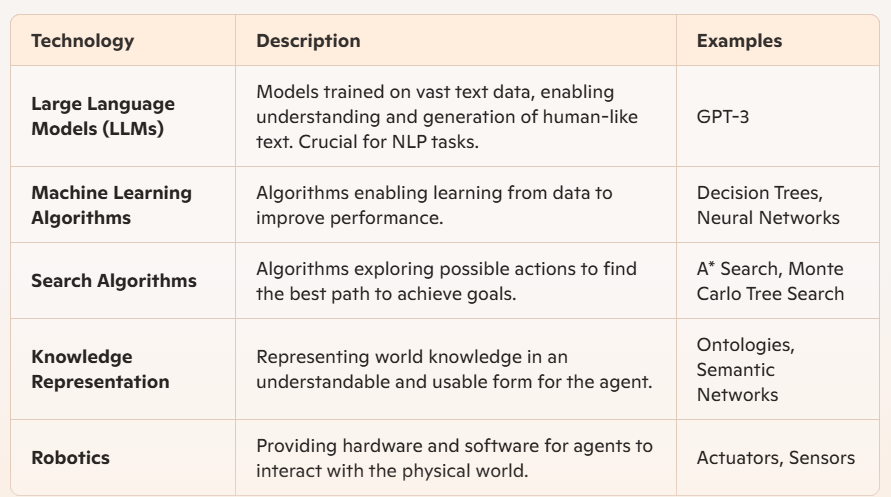
Several key technologies power AI agents:
- Large Language Models (LLMs): These models, trained on vast amounts of text data, enable agents to understand and generate human-like text. They are crucial for natural language processing tasks.
- Machine Learning Algorithms: These algorithms enable agents to learn from data and improve their performance. Examples include decision trees, support vector machines, and neural networks.
- Search Algorithms: These algorithms allow agents to explore different possible actions and find the best path to achieve their goals. Examples include A* search and Monte Carlo tree search.
- Knowledge Representation: This involves representing knowledge about the world in a way that the agent can understand and use. Examples include ontologies and semantic networks.
- Robotics: For agents that interact with the physical world, robotics provides the hardware and software to control actuators and sensors.
AI Agents in the Real World: Where You'll Find Them
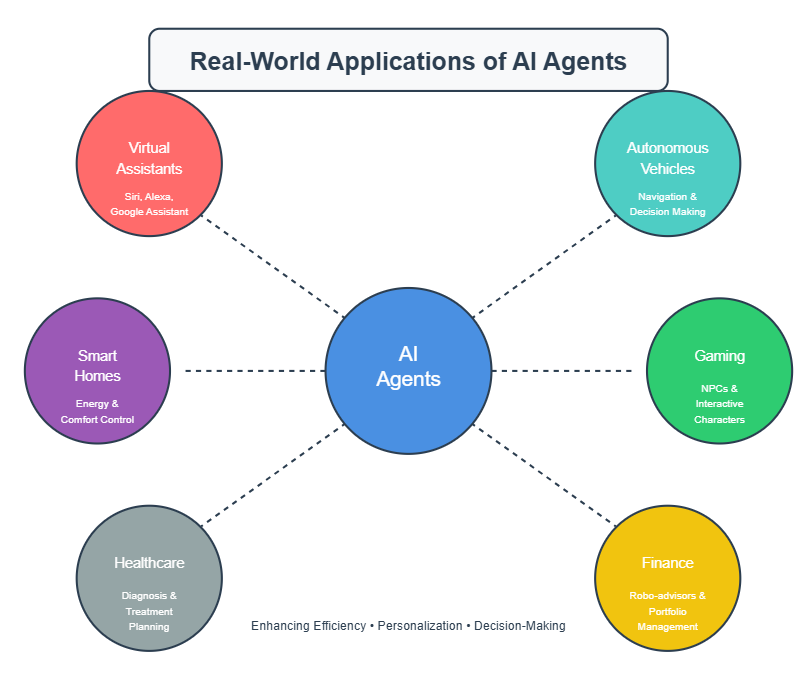
AI agents are already making a difference in many areas of our lives:
- Virtual Assistants: Siri, Alexa, and Google Assistant are AI agents that can answer your questions, set reminders, and control your smart home devices.
- Self-Driving Cars: These cars use AI agents to navigate roads, avoid obstacles, and make driving decisions.
- Medical Diagnosis: AI agents can analyze medical images and patient data to help doctors diagnose diseases more accurately.
- Financial Trading: AI agents can analyze market trends and make investment decisions.
- Customer Service Chatbots: These chatbots can answer your questions and help you with simple tasks, freeing up human customer service agents to handle more complex issues.
Understanding the Roles of AI Tools and AI Agents
Two terms that often get thrown around are “AI tools” and “AI agents,” and it’s easy to get them confused. While both leverage the power of AI, they serve fundamentally different purposes. Understanding this distinction is key to grasping the true potential of AI.
AI Tools: Your Specialized Assistants
Think of AI tools as highly skilled specialists, each designed to excel at a particular task. They’re like having a team of expert assistants, ready to help you with specific needs. Some common examples include:
- Content Creation Tools: These AI-powered writing assistants, like the neuroflash’s content suite can help you generate articles, marketing copy, emails, and more. They can suggest words, refine your prose, and even help you brainstorm ideas. They’re great for boosting productivity and overcoming writer’s block.
- Chatbots: These conversational AI programs are designed to simulate human interaction. They’re commonly used for customer service, answering frequently asked questions, and providing 24/7 support.
- Image and Video Editing Tools: AI is revolutionizing creative fields. AI-powered tools can now automate tedious tasks like background removal, enhance image quality, and even generate entirely new images or videos.
- Code Generation Tools: For developers, AI tools can assist with writing code, debugging, and even generating entire code blocks based on natural language descriptions.
The defining characteristic of AI tools is their narrow focus. They are optimized for a specific job and require human input to initiate and guide their actions. While they may learn and improve over time within their specialized area, they don’t typically adapt to new contexts or handle broader objectives.
AI Agents: The Autonomous Actors
AI agents, on the other hand, are more like independent actors. They’re designed to not just assist with a task, but to actually own a goal and work towards it autonomously. They’re less like specialized assistants and more like intelligent managers. Consider these examples:
- Self-Driving Cars: These vehicles use AI agents to perceive their environment, make complex driving decisions, and navigate roads without human intervention. They’re not just assisting a driver; they are the driver.
- Personalized Recommendation Systems: Think of how Netflix or Amazon suggests products you might like. These platforms use AI agents to learn your preferences and proactively recommend items. They’re not just showing you a list of products; they’re actively trying to predict and fulfill your needs.
- AI-Powered Robots: Robots used in manufacturing, logistics, or even healthcare often have AI agents that allow them to perform tasks autonomously, adapt to changes in their environment, and even collaborate with other robots.
The key difference with AI agents is autonomy. They can make decisions and take actions independently, with minimal human guidance. They can also handle multiple tasks and work towards a larger, overarching goal.
Think of it this way:
- AI tools are like having a specialized assistant for each task. You tell them what to do, and they do it well.
- AI agents are like having a general manager who can oversee multiple tasks and make decisions to achieve a broader objective. They can even delegate tasks to other AI tools or agents.
Connection Between AI Tools and AI Agents:
AI agents often utilize AI tools to perform their tasks. While AI tools focus on specific functions, AI agents integrate multiple tools to carry out complex tasks autonomously. For example, an AI agent managing a project might use data analysis tools to assess progress, communication tools to interact with team members, and scheduling tools to organize meetings. This integration allows AI agents to handle a broader range of activities, providing more comprehensive solutions.
In summary, AI tools are specialized applications designed for specific tasks, whereas AI agents are autonomous systems that can integrate and utilize these tools to perform complex, goal-oriented activities.
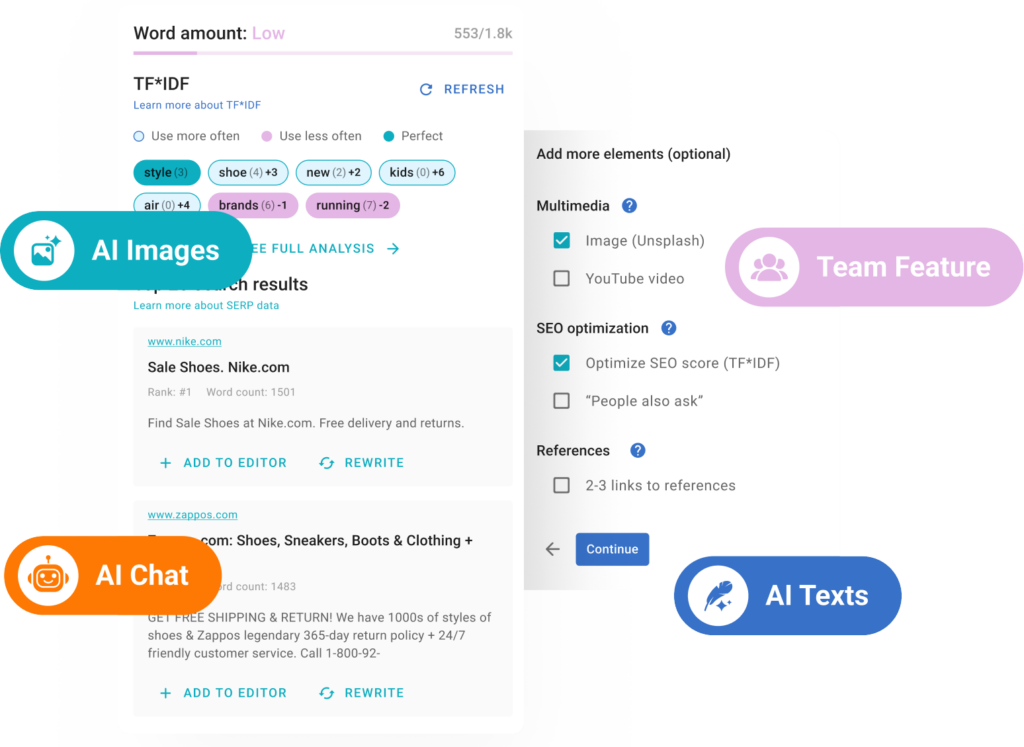
We’ll likely see more AI agents emerging that can seamlessly integrate various AI tools to achieve complex goals. Imagine an AI agent that can not only write marketing copy (using an AI writing tool) but also analyze market trends (using an AI analytics tool) and then automatically publish the content on social media (using an AI automation tool). That’s the power of AI agents!
Challenges and Considerations
While AI agents offer significant benefits, they also present challenges:
Ethical Concerns: Ensuring that AI agents make decisions that are ethical and unbiased is crucial.
Transparency: Understanding how AI agents arrive at specific decisions can be complex, leading to issues with accountability.
Security: Protecting AI agents from malicious attacks is essential to maintain their integrity and trustworthiness.
Dependence: Over-reliance on AI agents could lead to skill degradation in humans and potential vulnerabilities if the systems fail.
Addressing these challenges requires ongoing research, robust design principles, and comprehensive regulatory frameworks to ensure that AI agents are developed and deployed responsibly.
In conclusion, AI agents are revolutionizing the way tasks are performed across various industries. Understanding their workings, types, applications, and the associated challenges is essential as we continue to integrate these intelligent systems into our daily lives.
The Future of AI Agents
AI agents are poised to revolutionize numerous fields, from healthcare and finance to transportation and entertainment. As research progresses and technology advances, we can expect to see even more sophisticated and capable AI agents in the future, transforming the way we interact with technology and the world around us. Continued focus on ethical development, transparency, and robustness will be crucial to ensure that AI agents are used for the benefit of humanity.


